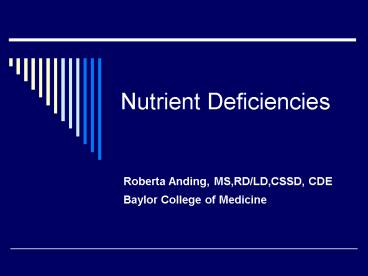Nutrient Deficiencies PowerPoint PPT Presentation
1 / 33
Title: Nutrient Deficiencies
1
Nutrient Deficiencies
- Roberta Anding, MS,RD/LD,CSSD, CDE
- Baylor College of Medicine
2
Goals and Objectives
- List common nutrient deficiencies
- Identify vulnerable nutrients in adolescents
- Describe physical findings associated with
nutrient deficiencies
3
Nutrient Deficiencies
- Macronutrients
- Calories
- Carbohydrate
- Protein
- Fat
- Micronutrients
- Vitamins/Minerals
4
Macronutrients
- Calories
- Marasmus
- Anorexia nervosa
- Preservation of serum proteins
5
Protein
- Hypoalbuminemic malnutrition
- Kwashiorkor
- Stressed starvation
- Alteration in fuel utilization
- Characterized by
- Low serum protein
- Edema
- Weight gain
6
At risk
- Water soluble vitamins
- Malabsorption
- Dietary restriction
- Chronic dieting
- Anorexia nervosa
- Food group restrictions
- Medications
7
B Vitamins
- In general, are cofactors of metabolism
- Many forms of Vitamin B
- Alcohol can increase risk of deficiency
8
Vitamin B12
- Food source- animal only
- Vegans
- Bariatric surgery
- Metformin use
9
Niacin
- Good for lowering cholesterol
- Causes vessel dilation
- Sources protein containing foods and fortified
cereals - Alcoholics are at increased risk of deficiencies
- Main deficiency is pellagra
10
Vitamin B6 - Pyridoxine
- Food source- Bananas, protein containing foods,
fortified cereals - Cofactor of amino group transfer
- Water soluble and is not stored
11
Thiamine
- Food source- Pork and fortified cereals
- Necessary for metabolism of carbohydrate
- Deficiency known as Beriberi
12
Riboflavin
- Food source - Cows milk and fortified cereals
- Deficiency can cause cracks and fissures at
corners of mouth (cheilosis)
13
Vitamin C deficiency
- Deficiency disease-scurvy
- Infants feed surrogate formulas
- Secondary iron deficiency anemia
14
Folic acid
- Food sources include fortified breakfast
cereals/green leafy vegetable - Need for one carbon transfer and cell
development-prevention of neural tube defects - Macrocytic anemia-mean corpuscular volume
- Sexually active-folic acid supplements
15
Folic acid fortification
- US Public Health Service/FDA increased folic acid
level of foods in 1998 - Mean intake increased approximately 100 ug per
day - Less than 50 of women age 15-44 reach 400 ug of
folic acid/day - Approximately 30 of minority women reach this
goal
16
Vitamin A
- Precursor - carotenoids
- Sources Carrots and other yellow and green
vegetables and fruits - Needed for normal vision and healthy epitheliol
cells - Anti-cancer activities found in this group
17
Vitamin A
- Deficiency keratinization of skin and eyes.
- Avtive/preformed VA can be toxic and large
amounts can cause birth defects
18
Vitamin D
- Deficiency emerging as the newest public health
concern - Decreased absorption and activity can occur with
anticonvulsants, bile acid sequestrants mineral
oil, cimetidine neomycin - Intake has decreased from the 1950
- Increased use of sunscreen
19
Vitamin D
- Works synergistically to promote bone mineral
density - Approximately 10 of calcium absorbed with
vitamin D deficiency - Needed for normal cell differentiation
- Multiple sclerosis
- Type 1 diabetes
- Breast cancer
20
Vitamin D deficiency
- Decreased bone mineral density
- Rickets
- Traditional deficiency
21
Vitamin E
- Family of compounds known as Tocopherols
- Primary role is anti-oxidant
- Sources nuts, oils, seeds
- Natural version better than synthetic
22
Vitamin K
- Needed for blood clotting
- Also plays integral role in bone growth
- Sources intestinal bacteria accounts for 75 of
requirements. - Other sources include broccoli, cabbage, green
leafy vegetables.
23
Vitamin K deficiency
- Can be caused by taking antibiotics
- Babies are given injection of VK at birth because
of sterile intestine - Symptoms
- Bruising easily
- Slow clotting
24
Calcium
- Bone mineral density
- Study of adolescent twins
- One twin received 1000 mg calcium
- One received placebo
- Significant difference in BMD over 12 months
- Data suggests that calcium deficiency is a
primary cause of decreased BMD
25
Calcium
- Deficiency can be caused by
- Inadequate dairy intake
- Alternative is calcium fortified juice
- Calcium competes with iron zinc and magnesium
- Calcium depletion may occur with chronic use of
corticosteroids and laxatives
26
Iron
- Common mineral deficiency
- Males and females
27
Iron deficiency in adolescents
- Data from NHANES III indicates that the
prevalence of iron deficiency anemia is 7.9 in
Non Hispanic whites - Prevalence in Mexican Americans is 17.4 with an
unclear etiology - Data is less clear in African Americans
28
Magnesium
- Cofactor for most enzymes (ATP)
- Central molecule of chlorophyll
- Sources Green leafy vegetables and chocolate
- Alcohol and multiple medications can cause Mg
mal-absorption - Too much Mg can have diarrhetic effect
29
Sodium Potassium
- Sodium linked to hypertension
- Na can cause fluid retention
- Avg Houstonian consumes 8 g Na/day (16 X
requirement) - Higher Potassium diet can be used to control
blood pressure - K found exclusively in fruits and vegetables
30
Sodium Potassium
- The more processed the food, the lower the K
content, and the higher the Na content.
VS
31
Chromium
- Part of glucose tolerant factor
- Brewers yeast is best source
Selenium
- Primary role is as anti-oxidant
- Involved in enzyme metabolism
- Body guard Vitamin E
32
Zinc
- Deficiency and toxicity appear similar
- Both affect immune system
- Source same as iron (red meat)
33
Summary
- Nutrient deficiencies involve both macronutrients
and vitamins and minerals - Increased growth and development in adolescents
increase demand - Promoting a healthy diet and responsible
supplementation crosses all disciplines

